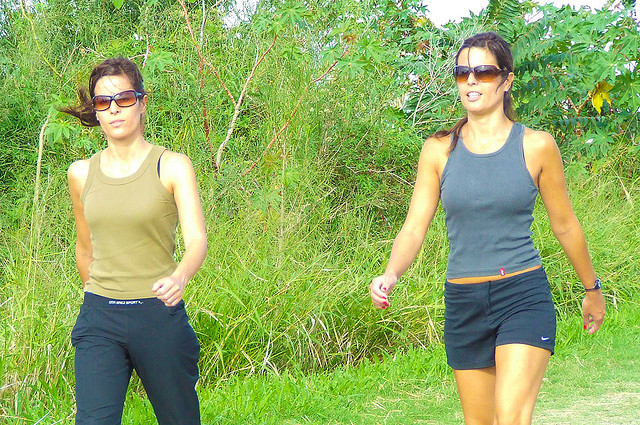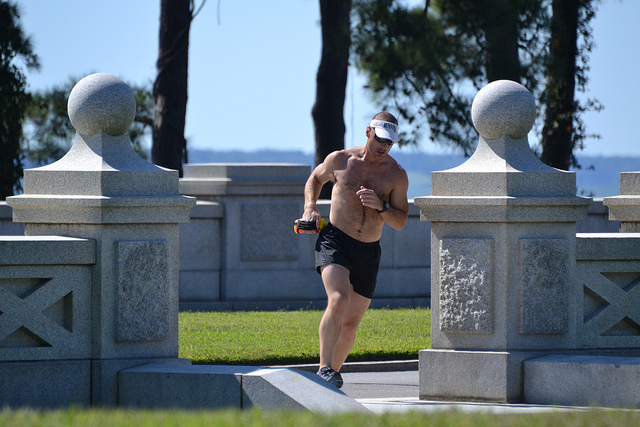
What should I do for cardio? I’m glad you asked!
You see, cardio training is one of those things that everyone needs, but most people don’t really like doing. Plus, there’s been a lot of controversy in recent years over what kind of cardio is best – or if we should be doing any cardio training at all. Fortunately, those people who base their decisions on ancient training wisdom and practices, experience, and science have known all along that cardio training should be a priority for most of us – regardless of what the mainstream media and fitness cults are telling us.
So, what’s the best way to do cardio? And is there an ultimate training program? Well, regardless of what you choose to do, the main things to focus on are:
a) getting some cardiovascular exercise several days per week
b) choosing an activity that you enjoy and will be more likely to stick with
c) challenging yourself to improve your performance a little bit each time you train
d) having fun and sticking with it for the long term
Now, there are many activities that are GREAT for cardiovascular training, such as walking, running, swimming, rope skipping, kickboxing, cycling, and hiking, just to name a few. Each activity can be used to provide a great cardiovascular stimulus, and each one comes with a unique set of pros and cons. For example, swimming is very joint-friendly, cycling can be used to commute, and hiking is a great stress reliever.
But given that we were born with two good feet (and not with bicycles, roller skates, or skis, etc.), I think that the ultimate cardio training program for general health and fitness would emphasize foot-powered travel (e.g. walking, running, etc.). And so, let me present my [adaptable] version of the ultimate foot-powered cardio training program.
Who is this program for?
If you just want to burn calories and improve your cardiovascular health, almost any vigorous physical activity will do the trick as long as you adhere to the points listed above. But if you’d also like to improve your performance in most athletic activities AND be better prepared for whatever challenges life throws at you – whether it’s some weekend B-Ball with friends or saving your child before she strays into a busy street – AND if you see cardio training as just one important piece of a well-balanced training program, then you’ll probably love this program.

The 5 Key Components of the Ultimate
Foot-Powered Cardio Training Program
Here’s how the program works: Since the ultimate cardio training program is ALWAYS one that is customized to your unique needs, goals, and preferences – rather than spoon-feed you some generic template – I’m going to give you the five key components, and YOU are going to assemble them into your own personalized cardio training program and schedule (using the examples below).
1) Walking – In this day and age, you can never get enough walking. It does your body, mind, and spirit good. Plus, anyone with two good legs can do it. For the purposes of this program, you can go for a walk every day of the week. And ideally, it should be done on days when other cardio training isn’t planned. It’ll help with your recovery, counter-act stress, boost your mood and creativity, along with many other great benefits, which I’ve discussed here.
Note: if you’d like some help getting started with just walking, check out my free walking program, which will help you progress quickly and safely. There’s also a great video on why you should become a walker here.
2) Running and/or Trotting – If you’re human, you were built to run and you should be able to run comfortably. And eventually, you should be able to run effortlessly. Running is a critical movement skill that takes practice to master, and running fast and/or long distances is a phenomenal way to build cardiovascular endurance, along with other conditioning benefits. For best health and fitness results, go for 2-3 varying runs per week, covering between 10-20 miles total, which is the sweet spot for most people. For example…
1st run: long, slow easy run (e.g. 4-12+ miles)
2nd run: some form of interval training (e.g. sprints, 400m repeats, etc.)
3rd run: moderate-intensity, paced run (e.g. 3200m, 5k, etc.)
Note: I’m a proponent of the POSE method of running. You can learn more about what it takes to become a strong, resilient, and successful runner here.
3) Hiking and/or Rucking – Hiking is a best-bang-for-your-buck cardio training option with a myriad of both physiological and practical benefits well-beyond cardiovascular health. If hiking isn’t feasible, a ruck will also do the trick. For best results, go for a hike or a ruck once or twice per week. And ideally, your hike will include changing terrain and grades.
Suggestion: think of hiking as something you GET to do, instead of something you have to do.
4) Cross Training – It’s a must. And for the purposes of this program, some of the best options are swimming, kickboxing, and dancing. But anything besides foot travel will be suitable for this program. For best results, do some kind of cross training once or twice per week. Challenge yourself, but don’t exhaust yourself. And of course, always enjoy yourself.
5) Rest – Ideally, you’ll take a minimum of one day per week off from all physical training – including cardio training.
 Here’s a sample weekly schedule:
Here’s a sample weekly schedule:
Note: Feel free to follow this sample schedule as-is or modify it to suit your preferences.
Monday – Easy, Long Run (e.g. 6-12 miles)
Tuesday – Brisk Walk (e.g. 20-60 minutes)
Wednesday – Moderate to High Intensity Interval Training Run (e.g. Fartleks, Wind Sprints, 400 Meter Repeats, etc.)
Thursday – Brisk Walk (e.g. 20-60 minutes)
Friday – Moderate Paced Run (e.g. 3-4 miles at race pace), Easy to Moderate Cross Training (e.g. swimming for 30-60 minutes)
Saturday – Hike (e.g. 2-4+ hour hike)
Sunday – Rest, Easy Walk, or Other Light Physical Activity (e.g. playing Frisbee)
The Short Version – Minimum Effective Dose
Now, let’s say that this schedule is totally impossible for you (and if it is, we should have a talk!). Here’s a much simpler and easier plan that will still deliver a lot of benefits while also being quite feasible for most people:
- 1-2 walks per week (more walking is encouraged, but optional)
- 1-2 runs per week (note: this strategy may come in handy for those who only run once or twice per week)
- 1 hike and/or cross training session per week (i.e. your preference)
Note: You’ll notice that I’ve left some elements of the programs above intentionally vague and somewhat open-ended. That’s by design.
IMPORTANT POINT: How to Stick With Your Cardio Program
It’s true that some people have the willpower, passion, and sheer tenacity to stick to a mind-numbingly boring cardio routine day-in and day-out. They do it because they’re supposed to, because it’s best, or because it’s simply on their program and/or it’s necessary to achieve their goals. These people are the exception, not the norm. Most people just aren’t like that. They need a little more umph to get their rears in gear.
Now, there are many strategies to address this conundrum, such as clarifying and aligning yourself with your purpose, passions, principles, and priorities, among others. But one of the easiest ways that I’ve found to stick with a “boring” cardio program is to look for the benefits between the lines.
Because if you’re doing cardio simply to lower your cholesterol levels because your doctor “said so,” your compliance will likely wane all too soon. It’s just not a motivating, inspiring, or even a desirable goal, for that matter. It’s like getting the timing belt on your car replaced. You drop a grand on a repair and the car still drives the same. So, instead of doing your cardio because you’re “supposed to,” look for the silver lining. Look for the intrinsic rewards. Look for the reasons why you can and will do this just because.
So, don’t just go on a walk just to burn calories or improve your heart health risk factors. Go on a walk because it’ll be refreshing. You’ll get to enjoy the fresh air, sunshine, or rain. You’ll get to reset your brain, boost your creativity, and solve problems that have been on your mind. You’ll get some quiet time – some “me time.” Plus, you’ll feel better when you’re done. You’ll also be able to concentrate better throughout the day. And yes, you’ll get some exercise, too, which is a nice little perk.
And if you’re going for a run, don’t do it to punish yourself and trade your time and effort for results. If you hate running because you suck at it, do something about that. Go for a run to challenge yourself. Make it a game. Manage your effort and stay away from pain. See if you can do better than you did last time – even if only a little bit (i.e. baby steps).
If you craft your program in a way that you look forward to, it won’t feel like “work,” and you won’t have a hard time sticking with it.
Notes
-The keys to success in this cardio training program are consistency, incremental progression (i.e. baby steps), intrinsic rewards and enjoyment. If you adhere to those points, you will succeed.
-To progress in your cardio training program, you can increase the duration of your sessions (i.e. walks, runs, hikes, etc.), increase your speed (and thus, the intensity) to cover more distance in the same amount of time (or less time), take less time to rest, or a combination of these – always being sure to progress very gradually from session to session.
-I’m a big proponent of walking, running, and hiking barefoot (when possible and relatively safe), which comes with an abundance of unique advantages. If you’re interested, here are some resources to get you started:
- The Definitive Guide For Going Barefoot (The Basics)
- Learn the Skill of Barefoot Running
- The Definitive Guide to Transitioning to Barefoot Running
-It should go without saying that proper warmups, cooldowns, and additional training are also necessary as part of this program, but this is beyond the scope of this article. As you know, cardiovascular training is merely one component of a well-rounded fitness training program.

Final Words
If you make the most of this cardio training program – customizing it to your individual needs, goals, and preferences – it will deliver a great return on your investment. Like I said in my article 100 Lessons I’ve Learned From 10 Years of Running, “the more I give to running, the more it gives back to me.” So it is with all good training.
And now, I will leave you with some food for thought…
- Starting somewhere is always better than never starting at all.
- Baby steps take a little longer in the beginning, but they always take you further in the end.
- It’s a lot easier to keep going than it is to restart.
So, if you need more cardio training in your life, draft up a simple plan – even if it’s braindead simple, ridiculously easy, and well-below your expectations – and begin immediately.
If you found this article helpful, please share it with your friends:
.jpg)
![]()
Health-First Fitness Coach
P.S. If you liked this post, then please signup for the newsletter, or follow me on Facebook or Twitter for daily updates and other interesting info.
Related Posts
- 8 Strategies to Maximize Your Results From Your Cardio Workouts
- How To Supercharge Your Long Distance Runs With The NEW Anti-Comfort Zone Paradigm
- The Holy Grail of High Intensity Interval Training
- What I Love Most About Running
- The ONE Exercise To Rule Them All
- Burn Fat, Build Willpower, and Get Healthier With This EASY Walking Program
- Persistence Hunting and Endurance Running: 5 Ways to Run Effortlessly

Hi John,
Really good topic and post! I work out 4 days a week but I always try and get cardio in. I usually go on a run or bike ride on the weekend, but also switch it up with HIIT in the gym.
I am actually off for a bike ride now!
Look forward to reading more.
All the best,
Harry Simonis
Thanks, Harry!